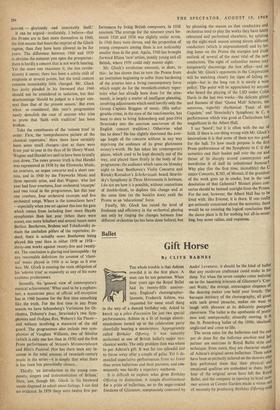Ballet
Gift Horse
By CLIVE BARNES
THE whole trouble is that Ashton overdid it in the first place. A man can be too generous. When four years ago the Royal Ballet had its twenty-fifth anniver- sary, England's choreographer- laureate, Frederick Ashton, was requested for some small thing in the way of a danced birthday ode. Asked to knock up a piece d'occasion for just two special performances, Ashton in a fit of benign absent- mindedness turned up at the celebration party cheerfully bearing a masterpiece. Appropriately called Birthday Offering, it was instantly acclaimed as one of British ballet's major neo- classical works. The only problem then was where to put Ashton's gift. It was far too splendid just to throw away after a couple of galas. Yet it de- manded superlative performances from no fewer than seven ballerinas and their partners, and con- sequently was hardly a repertory warhorse.
It is difficult to explain what gives Birthday Offering its distinction. A simple divertissement for a pride of ballerinas, set to the sugar-coated fondants of Glazunov, sumptuously costumed by Andre Levasseur, it should be the kind of ballet that any moderate craftsman could make in his sleep. Yet when the seven couples come waltzing on to the haunting triteness of Glazunov's 'Con cert Waltz,' the strange, extravagant elegance of the dancing makes you hold your breath. The baroque intricacy of the choreography, all given with such proud panache, makes Me want to laugh with pleasure at its delicately pompoul cleverness. The ballet is the apotheosis of prette ness and, unexpectedly, absurdly moving. It 0 the St. Petersburg ballet of the 1890s, idealised, anglicised and come to life.
The seven solos for the ballerinas and the one pas de deux for the ballerina assoluta and her partner are exercises in Royal Ballet style and technique. Even more, they are character studiel of Ashton's original seven ballerinas. These solos have been so perfectly tailored on the dancers 0° first performed them that their physical and emotional qualities are embedded in them. NO four of the original seven have left the RoYel Ballet, and the company in opening its brief giro' mer season at Covent Garden made a virtue out of necessity by producing Birthday Offering witil
only Fonteyn surviving. The other six ballerina roles with slightly modified solos were given to Young dancers, all with rightful ballerina aspira- tions, one with ballerina ranking, but none yet With complete ballerina status. In some Ways the new cast is the equal of the old, even if it lacks something in assurance. All .the ensemble Work goes with smooth finesse, yet in the solos (the ballet's heart and soul) minor disaster over- takes dancer after dancer as they try to mould themselves into the patterns laid down by the Physiques and temperaments of the original cast. Merle Park and Annette Page emerge victorious, and Fonteyn, of course, is as effulgent as ever, although I would have preferred less of the Gar- den party smile. The rest glimmer tantalisingly rather than glitter.
The ballet will not be restored to rights until either the company can find dancers who, by Chance, resemble Ashton's original muses, or Ashton himself completely re-choreographs new solos inspired by the new cast, if necessary to ?tiler Glazunov pieces. Dancers like Maryon Lane, Georgina Parkinson, Lynn Seymour and Antoinette Sibley are worth it. To say there is no such thing as bad dancers, Only bad ballets, is obviously crazy. Yet it con- tains a fraction of the truth, and unquestionably One of the main reasons for the mediocrity of London's Festival Ballet is its poveriy-stricken repertory. During the eleven years of the com- pany's existence it has produced remarkably few works even of reasonable pretensions, let alone positive value. Among this unhappy few is Jack Carter's dance-drama, The Witch Boy, which is worth a grand army of Bona parses at Nice and a monthful of London Mornings. Carter's ballet, like the play Dark of the Moon, is freely based on the ballad of Barbara Allen. It has reduced the ballad to a simple, flowing narrative, and has a trick ending Alfred Hitchcock wouldn't tell his brother. Choreographically The Witch Boy is not particularly original, and the powerful influences of Antony Tudor (or, at least, pseudo-Tudor) and Agnes de Mille are sometimes too evidently apparent. Despite this, Carter is a fine producer, his ballets (and this is not his best) have the shrewd theatricality Puccini brings to opera, and his choreography is unusually fluent. These days it seems downright compromising, if not dispar- aging, to call a work entertaining. Yet that is what The Witch Boy is. The role of the Witch Boy, first danced by John Gilpin, is now shared by Ronald Emblen, who gives it a highly charged dramatic performance. Indeed, the whole com- pany dance well in this, almost visibly breaking through the cocoons of choreographic mush too often smothering them.



































 Previous page
Previous page